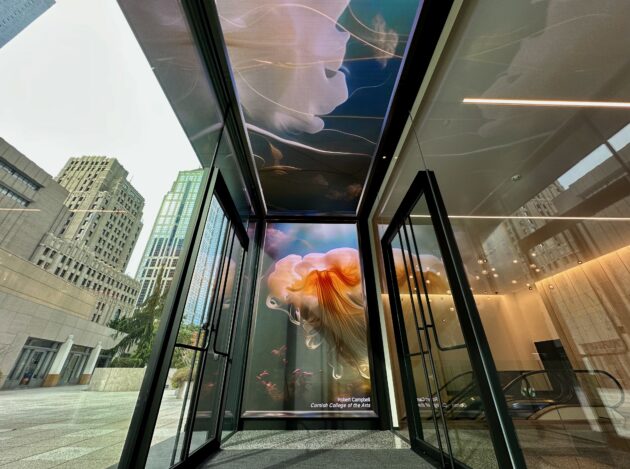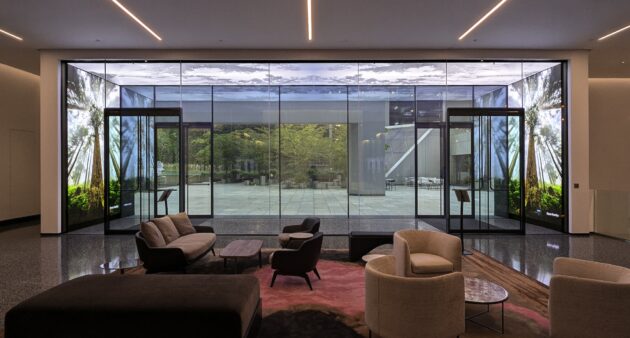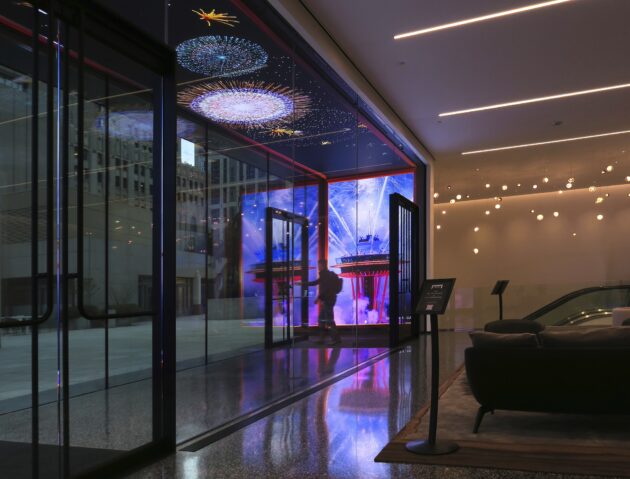Get in the picture: High-tech ‘Portal’ is a visual delight for those entering Seattle office building
Stepping into work never looked this good.
A digital “moment of zen” has taken shape at a downtown Seattle office building, using cutting-edge technology and AI tools to showcase iconic photography from around the Pacific Northwest.
“The Portal” is a new 180-degree art-filled entryway at the redeveloped lobby of One Union Square, a 36-story skyscraper built in 1981. Visitors entering and exiting the building are treated to massive images showcasing the region’s natural beauty and its built environment, from Mount Rainier to the Space Needle.
The Portal is 14-feet high and 42-feet wide, with walls and ceilings lined with 248 high-resolution LED panels that offer super high image resolution. For comparison, a high-end HDTV performs at 4K wide, while the Portal offers the equivalent of 13K wide, maintaining color and sharpness from any angle around the entryway.
Conceived by building owner Washington Holdings, the Portal was developed by Bellevue, Wash.-based Lightspeed Design, a longtime visual effects company that performs a variety of creative and technical work.
“This is a really exciting thing, because it’s embedded in the building. It’s part of the building,” said Chris Ward, president of Lightspeed Design, during a recent GeekWire tour of the display.

Lightspeed previously worked with the Space Needle to enhance a live New Year’s Eve fireworks display with a layer of augmented reality effects.
The Portal doesn’t just feature static images blown up to fill the desired space. Throughout a roughly 45-minute iteration of a 50-image “show,” panning and scanning across images is achieved in extreme detail with the help of artificial intelligence. Lightspeed relies on tools from Topaz Labs, makers of photo and video editing software.
“The AI has allowed us to do something new,” Ward said. “We would have done this years ago, and it would just look different. This is now allowing us to maintain the integrity of the original photography as it gets blown up to 13K.”
At one point, an aerial image shot high over Lake Union zooms way in on some of the houseboats and people swimming below, creating surprisingly sharp subcomponents of the main image.
“Mostly, it’s enhancing what’s there, and interpolating a blob into a smaller, sharper blob,” said Lightspeed art director Bob Mueller. “It doesn’t know what it’s looking at for the most part, but it knows through millions of images that it’s been trained on what this kind of blob should have looked like.”
Ward called AI a valuable tool that supports the artists and actually enhances their work.
“It’s not actually in competition with people,” he said. “I think people view AI in this suspicious manner in the creative community.”

Alongside photographs and videos there are real-time simulations mixed in, such as randomly generated sky and cloud formations. The simulations accurately update the position of the sun (and at night, stars) for Seattle’s exact day and time at The Portal’s exact longitude and latitude.
Washington Holdings has invested more than $120 million in upgrades to tenant-facing spaces of One and Two Union Square. The current renovation of One Union is by Seattle-based architecture firm GGLO.
The Portal does not produce any sound, and the only type in the display is credits to the artists and photographers. The Union Square website contains a list of those whose work is involved, with organizations such as the City of Seattle Office of Arts and Culture, NASA, MOHAI, Seattle Public Library, and the Space Needle granting usage permissions.
From the courtyard outside, especially at night, the entryway could be viewed as a dynamic new piece of public art in the city.
Washington Holdings CEO Craig Wrench said the goal was “to create a visual, and perhaps unexpected, moment in the building where tenants and guests might be moved in a positive way as they passed by or through it.”
Standing in The Portal, between the glass exterior and interior walls of One Union Square, I watched as office workers came and went past the immersive display. Some moved through it heads down on phones or hurriedly to their next appointment. Others clearly took in the few seconds of whatever image was onscreen during their passing — the Blue Angels flying overhead; a crashing coastal wave; an owl in a forest; fireworks bursting over the Space Needle.
“Even if they don’t consciously see it, they’ll subconsciously see something of beauty,” Mueller said of those passing through.
Keep scrolling for more photos:







